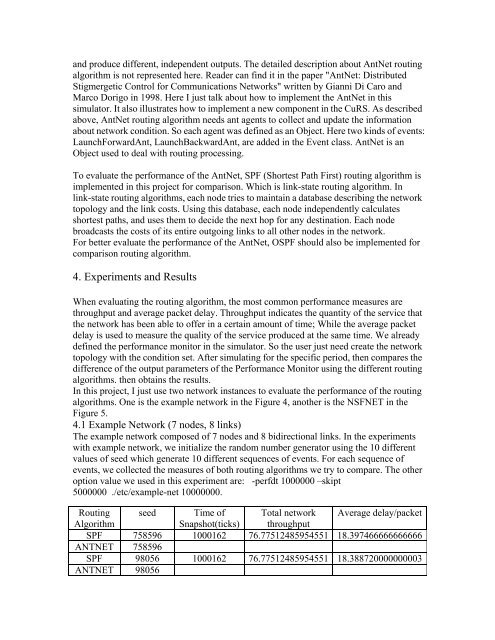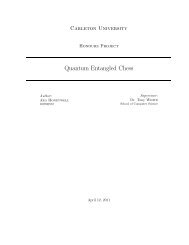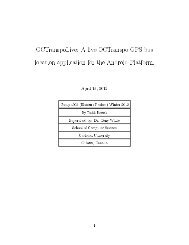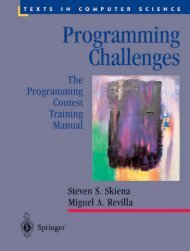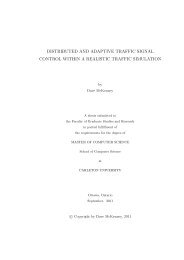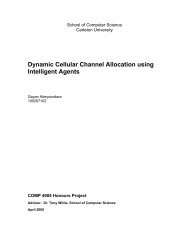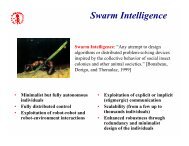Implement a simulator, in Java, for evaluating AntNet routing protocol
Implement a simulator, in Java, for evaluating AntNet routing protocol
Implement a simulator, in Java, for evaluating AntNet routing protocol
You also want an ePaper? Increase the reach of your titles
YUMPU automatically turns print PDFs into web optimized ePapers that Google loves.
and produce different, <strong>in</strong>dependent outputs. The detailed description about <strong>AntNet</strong> rout<strong>in</strong>galgorithm is not represented here. Reader can f<strong>in</strong>d it <strong>in</strong> the paper "<strong>AntNet</strong>: DistributedStigmergetic Control <strong>for</strong> Communications Networks" written by Gianni Di Caro andMarco Dorigo <strong>in</strong> 1998. Here I just talk about how to implement the <strong>AntNet</strong> <strong>in</strong> this<strong>simulator</strong>. It also illustrates how to implement a new component <strong>in</strong> the CuRS. As describedabove, <strong>AntNet</strong> rout<strong>in</strong>g algorithm needs ant agents to collect and update the <strong>in</strong><strong>for</strong>mationabout network condition. So each agent was def<strong>in</strong>ed as an Object. Here two k<strong>in</strong>ds of events:LaunchForwardAnt, LaunchBackwardAnt, are added <strong>in</strong> the Event class. <strong>AntNet</strong> is anObject used to deal with rout<strong>in</strong>g process<strong>in</strong>g.To evaluate the per<strong>for</strong>mance of the <strong>AntNet</strong>, SPF (Shortest Path First) rout<strong>in</strong>g algorithm isimplemented <strong>in</strong> this project <strong>for</strong> comparison. Which is l<strong>in</strong>k-state rout<strong>in</strong>g algorithm. Inl<strong>in</strong>k-state rout<strong>in</strong>g algorithms, each node tries to ma<strong>in</strong>ta<strong>in</strong> a database describ<strong>in</strong>g the networktopology and the l<strong>in</strong>k costs. Us<strong>in</strong>g this database, each node <strong>in</strong>dependently calculatesshortest paths, and uses them to decide the next hop <strong>for</strong> any dest<strong>in</strong>ation. Each nodebroadcasts the costs of its entire outgo<strong>in</strong>g l<strong>in</strong>ks to all other nodes <strong>in</strong> the network.For better evaluate the per<strong>for</strong>mance of the <strong>AntNet</strong>, OSPF should also be implemented <strong>for</strong>comparison rout<strong>in</strong>g algorithm.4. Experiments and ResultsWhen evaluat<strong>in</strong>g the rout<strong>in</strong>g algorithm, the most common per<strong>for</strong>mance measures arethroughput and average packet delay. Throughput <strong>in</strong>dicates the quantity of the service thatthe network has been able to offer <strong>in</strong> a certa<strong>in</strong> amount of time; While the average packetdelay is used to measure the quality of the service produced at the same time. We alreadydef<strong>in</strong>ed the per<strong>for</strong>mance monitor <strong>in</strong> the <strong>simulator</strong>. So the user just need create the networktopology with the condition set. After simulat<strong>in</strong>g <strong>for</strong> the specific period, then compares thedifference of the output parameters of the Per<strong>for</strong>mance Monitor us<strong>in</strong>g the different rout<strong>in</strong>galgorithms. then obta<strong>in</strong>s the results.In this project, I just use two network <strong>in</strong>stances to evaluate the per<strong>for</strong>mance of the rout<strong>in</strong>galgorithms. One is the example network <strong>in</strong> the Figure 4, another is the NSFNET <strong>in</strong> theFigure 5.4.1 Example Network (7 nodes, 8 l<strong>in</strong>ks)The example network composed of 7 nodes and 8 bidirectional l<strong>in</strong>ks. In the experimentswith example network, we <strong>in</strong>itialize the random number generator us<strong>in</strong>g the 10 differentvalues of seed which generate 10 different sequences of events. For each sequence ofevents, we collected the measures of both rout<strong>in</strong>g algorithms we try to compare. The otheroption value we used <strong>in</strong> this experiment are: -perfdt 1000000 –skipt5000000 ./etc/example-net 10000000.Rout<strong>in</strong>g seed Time of Total network Average delay/packetAlgorithmSnapshot(ticks) throughputSPF 758596 1000162 76.77512485954551 18.397466666666666ANTNET 758596SPF 98056 1000162 76.77512485954551 18.388720000000003ANTNET 98056


